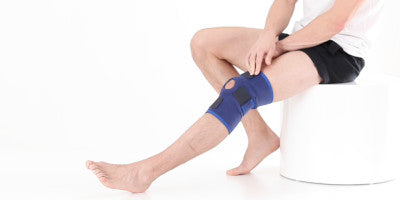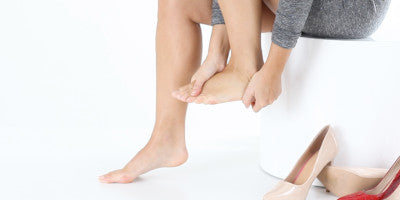What is Plantar Fasciitis?
Plantar fasciitis is a common foot condition characterized by inflammation of the plantar fascia, a thick band of tissue that runs along the bottom of the foot and connects the heel bone to the toes. This inflammation typically leads to sharp heel pain (but also general foot pain, including pain in arch of foot), especially with the first steps in the morning. While the pain can be intense, it often improves after a few minutes of walking, but it may return after prolonged standing or sitting.
Sufferers often ask “why does plantar fasciitis hurt in the morning?” One of the reasons plantar fasciitis is most painful in the morning is because the plantar fascia tightens overnight while you sleep. When you take those first steps in the morning, the tissue is suddenly stretched, causing irritation and discomfort.
When faced with the condition, you may anxiously ask, is plantar fasciitis permanent? Plantar fasciitis is not necessarily a permanent condition, but it can persist for several months if not treated properly. It's a very common issue, particularly among runners, athletes, and people who spend a lot of time on their feet.
While plantar fasciitis primarily affects the heel, it can sometimes cause plantar fasciitis swelling in the foot. Some people may also experience pain that radiates to the toes, though this is less common. Going the other way, plantar fasciitis does not directly affect the ankle. However, compensating for heel pain can lead to altered walking patterns that may, cause discomfort in other parts of the foot, including the ankle.
There is a connection however between plantar fasciitis and Achilles tendonitis. Plantar fasciitis and Achilles tendonitis are closely related due to their proximity and the interconnected nature of the foot’s structures. Both conditions involve inflammation of tissues that play key roles in foot movement and stability. The plantar fascia and the Achilles tendon work together to support the arch of the foot and facilitate movement during activities like walking and running. When one is inflamed or strained, it can put additional stress on the other. For example, if the Achilles tendon is tight or injured, it may cause the plantar fascia to overcompensate, leading to plantar fasciitis. Similarly, inflammation in the plantar fascia can lead to altered foot mechanics, which may strain the Achilles tendon, causing Achilles tendonitis.
"Plantar fasciitis is a common foot condition characterized by inflammation of the plantar fascia, a thick band of tissue that runs along the bottom of the foot and connects the heel bone to the toes."

What Causes Plantar Fasciitis?
Searching for a plantar fasciitis cause can lead to several factors, most of which involve excessive strain on the plantar fascia. Common triggers include:
- Overuse
- Improper foot mechanics
- Activities that involve repetitive stress on the heel and arch of the foot—such as running or standing for long periods
- Tight calf muscles, obesity, and age can also increase the likelihood of developing plantar fasciitis.
One common question is, Can shoes cause plantar fasciitis? The answer is yes. Wearing shoes that lack proper arch support or cushioning can place undue stress on the plantar fascia, contributing to the development of this painful condition. Shoes with poor support can fail to distribute pressure evenly across the foot, causing the fascia to overstretch and become inflamed.
This is particularly true for individuals with flat feet, who have less natural arch support. Without the right shoes to compensate for the lack of arch, flat feet can increase strain on the plantar fascia, making the wearer more susceptible to plantar fasciitis and arch pain.
High heels are another common culprit, as they force the foot into an unnatural position, tightening the Achilles tendon and adding stress to the heel and arch. Similarly, worn-out shoes that have lost their cushioning can no longer absorb impact properly, further aggravating the plantar fascia and potentially leading to plantar fasciitis.
Therefore, choosing shoes or orthotic insoles with adequate high arch support is essential for preventing or managing this condition.
As plantar fasciitis symptoms typically include sharp pain in the heel, some people also develop a heel spur, which is a
bony growth on the heel bone. Although it is not the direct cause of the pain associated with plantar fasciitis, the presence of a heel spur can indicate long-standing tension on the plantar fascia and may exacerbate discomfort.
Why Does Plantar Fasciitis Hurt in the Morning?
Plantar fasciitis pain is often most intense first thing in the morning due to how the plantar fascia tightens during rest. While sleeping, your feet are typically in a relaxed, flexed position, which allows the plantar fascia to contract. This tightness can become problematic once you stand up and start moving again. The sudden stretching of the inflamed tissue as you take your first steps can causes sharp, stabbing heel pain.
Overnight, the natural healing processes of the body may work to repair tiny tears in the fascia, but these efforts are disrupted when the fascia is quickly stretched upon waking. This phenomenon is also why pain can resurface after periods of sitting or inactivity during the day. Gentle stretching before getting out of bed can help ease the discomfort, as it prepares the plantar fascia for movement and reduces the shock of that first step.
Start with a calf stretch by sitting up and wrapping a towel or resistance band around the ball of your foot, gently pulling it toward you to stretch the calf and the plantar fascia. You can also do toe stretches by flexing and extending your toes several times.
Another effective stretch is the ankle roll, where you rotate your ankles in circles to loosen up the fascia and surrounding muscles.
Doing these stretches while still in bed helps prepare the plantar fascia for movement, reducing the sharp pain often felt with those first steps.

"While sleeping, your feet are typically in a relaxed, flexed position, which allows the plantar fascia to contract. This tightness can become problematic once you stand up and start moving again."
How Long Does Plantar Fasciitis Last?
The duration of plantar fasciitis varies depending on the severity of the condition and how quickly it's treated. For many people, with proper care, symptoms may improve within a few weeks to several months. However, without treatment or if the condition is aggravated by continued stress on the foot, it can persist for a longer period.
Is plantar fasciitis permanent? Fortunately, no, plantar fasciitis is not typically permanent. With the right combination of rest, stretching, supportive footwear, and possibly physical therapy or other medical interventions, most people fully recover. In some cases, though, the condition can become chronic, especially if the underlying causes, like poor foot mechanics or improper footwear, are not addressed.
Dr Dana Canuso Explains Plantar Fasciitis
Plantar Fasciitis Treatment
When considering how to treat plantar fasciitis, there are several effective options ranging from at-home remedies to medical interventions.
A key component of treatment is relieving tension in the plantar fascia through plantar fasciitis stretches and plantar fasciitis exercises.
Common stretches for plantar fasciitis include calf stretches, toe stretches, and rolling the foot over a tennis ball to loosen the fascia and surrounding muscles.
Strengthening exercises for the foot and lower leg can also help improve support for the arch and reduce stress on the plantar fascia. Any of the aforementioned would be considered a good treatment for plantar fasciitis.
One question often asked is, is walking good for plantar fasciitis? The answer depends on the severity of your condition. In mild cases, walking can help keep the muscles and fascia flexible, promoting healing. However, in more severe cases, excessive walking—especially on hard surfaces or without proper footwear—can exacerbate the condition.
It's important to listen to your body and consult a healthcare provider for guidance on activity levels.

Top Plantar Fasciitis Exercies
Plantar Fasciitis Pain Relief
In addition to plantar fasciitis inserts, managing symptoms from the outset is key. Many people find relief by wearing plantar fasciitis socks, which come equipped with features like an integrated silicone heel cushion insert for added comfort and Multi Zone Compression to target and reduce plantar fasciitis swelling. These socks can provide additional support to the plantar fascia throughout the day, helping the tissue recover more effectively.
Long Term Plantar Fasciitis Correction
A crucial part of treating plantar fasciitis is choosing the right footwear. Thankfully, you don’t need to buy specific Plantar fasciitis shoes. You can simply enhance your own shoes with orthotic plantar fasciitis inserts with true arch support, which are essential for alleviating arch pain and redistributing weight more evenly across the foot. The combination of proper arch support and cushioning can greatly reduce the strain on the plantar fascia, preventing further inflammation and aiding in recovery.
Orthotic insoles with deep heel cups will also help to stabilise the foot, further reducing plantar fascia strain.
Plantar Fasciitis Physical Therapy
For those who are struggling to manage their plantar fasciitis at home, professional help may be a good option. A popular method used by physical therapists is the plantar fasciitis massage, which focuses on loosening the tissue and reducing inflammation. Regularly massaging areas of heel and arch pain can alleviate tension and promote blood flow to the area, helping with recovery. Physical therapy for plantar fasciitis may also be recommended as a heel pain treatment, to guide you through specialized exercises and techniques to manage the condition and prevent future flare-ups.
In more severe cases where conservative treatments fail, plantar fasciitis surgery may be considered. This typically involves releasing the plantar fascia to reduce tension and inflammation, but surgery is generally seen as a last resort. Most people can manage and recover from plantar fasciitis with less invasive methods, but for chronic, unresponsive cases, surgical intervention may be the best option.
Achilles Tendonitis Treatment
As mentioned above, plantar fasciitis can lead to Achilles tendonitis and vice versa, as both conditions are often linked by overuse and strain on the foot's supporting structures. Treatment for Achilles tendonitis focuses on reducing inflammation and promoting healing of the tendon. Achilles tendon pain is typically felt just above the heel and may be accompanied by stiffness and swelling. Achilles tendinitis symptoms can worsen after physical activity or after long periods of rest.
To treat Achilles tendonitis, rest and gentle stretching are key. Achilles tendonitis exercises, such as calf stretches, eccentric heel drops, and resistance band exercises, help strengthen the surrounding muscles and reduce strain on the tendon. Wearing an Achilles Tendon Support can provide additional stability and reduce stress during daily activities. Supports that feature a silicone tendon cushion can help to protect support the Achilles tendon. Support such as these help to alleviate pain while promoting healing by limiting excessive movement and providing compression to the affected area.
How To Prevent Plantar Fasciitis
Preventing plantar fasciitis involves a combination of lifestyle adjustments and mindful practices:
- Start by wearing supportive footwear, with plantar fasciitis inserts that offer adequate arch support and cushioning.
- You should avoid walking barefoot on hard surfaces or using worn-out shoes.
- Incorporate regular stretching exercises for your calves and the plantar fascia into your routine to maintain flexibility and reduce strain.
- Strengthening the muscles in your feet and legs can also help distribute pressure more evenly and prevent overuse injuries.
- Additionally, if you engage in high-impact activities, consider using orthotic inserts to provide extra support and cushioning.
- Maintaining a healthy weight can also lessen the stress on your feet.
By taking these proactive steps, you can significantly reduce your risk of developing plantar fasciitis and keep your feet feeling their best.

"Strengthening the muscles in your feet and legs can also help distribute pressure more evenly and prevent overuse injuries. "
Understanding and addressing plantar fasciitis involves a multifaceted approach that tackles both the symptoms and underlying causes of this common foot condition. From recognising the intense heel pain that often worsens in the morning to implementing effective treatments like plantar fasciitis stretches and exercises, each step is crucial for managing and eventually overcoming the discomfort.
Proper footwear, including orthotic plantar fasciitis inserts and supportive features, play a significant role in alleviating pain and preventing further strain.
Additionally, integrating strategies such as a plantar fasciitis massage and physical therapy can enhance recovery.
For related issues like Achilles tendonitis, targeted Achilles tendonitis exercises and supports are also essential.
By taking a comprehensive approach and addressing these factors, you can significantly improve your foot health and quality of life.
Disclaimer
The content on this website is provided for general information and reference purposes only and is not intended to substitute for advice given by a physician, pharmacist, or other licensed health-care professional. You should not use this information as self-diagnosis or for treating a health problem or disease. All exercises and information featured on this web site should only be reviewed/practised under the supervision of a qualified healthcare professional. Products suggestions linked to injuries may be provided on the site but you must always refer to the product page for full product details and always consult a physician before use as the indications outlined may not always be relevant to your particular injury/condition.







































